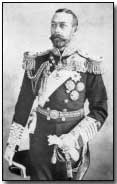Who's Who - King George V
 George V (1865-1936) was born on 3 June
1865, the second son of Edward VII and Alexandra.
George V (1865-1936) was born on 3 June
1865, the second son of Edward VII and Alexandra.
Following a cursory education at home George opted for a naval career in 1877, serving with his older brother Albert as naval cadets and until the latter left to study at Trinity College in 1882. George remained in the navy as a professional officer until Albert's death in 1892. From this point onwards George assumed the role of the heir-apparent.
In 1893 he married Princess Mary of Teck, a great-granddaughter of George III. The couple had six children - five sons and a daughter (of which one - John - suffered from epilepsy and (probably) autism, and was hidden from public view).
With Queen Victoria's death on 22 January 1901 and Edward VII's accession to the throne, George became direct heir to the throne.
George's tenure as monarch - 1910-36 - began in the midst of a constitutional crisis in Britain. The Liberal government, under Prime Minister Asquith and Chancellor of the Exchequer Lloyd George, were in dispute with the House of Lords, Parliament's upper chamber.
The Conservative-dominated upper chamber had rejected Lloyd George's annual finance bill of 1909, a controversial budget which included several significant social welfare provisions. The government was deadlocked with the unelected Lords, and threatened to flood the upper chamber with specially created peers simply in order to force its finance bill through Parliament.
It was in this context that George V was faced with a difficult decision. Asquith and Lloyd George required the King's consent to create such a large number of new peers; naturally the Conservative opposition expected the monarch to refuse to break with convention in creating so many party political peers.
Eventually George agreed to Asquith's request to grant permission to create the new peers if necessary; at which point the Lords capitulated and passed Lloyd George's budget. As a consequence of the crisis however, the Parliament Act of 1911 was enacted which severely cut back the power of the Lords, including its right of veto of government bills.
During the First World War King George - and his wife May (as Mary was known) - visited the Western Front on several occasions. During one such visit his horse rolled on top of him, breaking his pelvis, an injury that plagued him for the rest of his life.
In the midst of the war, in 1917, and sensitive of the Royal Family's German background, George changed the family name from the too-German sounding Saxe-Coburg-Gotha to Windsor.
That same year George controversially denied the Russian Tsar Nicholas II - George's cousin - and his family asylum in Britain following the Russian Revolution. The Tsar was subsequently arrested and murdered by the Bolsheviks.
The depression of 1929-31 convinced George that a unity government was required in order for the nation to unite in combating the prevalent poverty of the time. To that end he persuaded the three major political parties to enter into a temporary government coalition, Labour, Liberal and the Conservatives.
During George's reign Britain's relationship with its colonies underwent a number of changes. Ireland was divided along religious lines in 1920 with the south being self-governing; and Canada, Australia, New Zealand and South Africa demanded and received the right to self governance, which led to the creation in 1931 of the British Commonwealth of Nations. India gained a measure of self-governance in 1935.
George V was considered neither well-educated nor well-read, and nor was he a popular wit or raconteur. However he embodied diligence, duty and duty. He sought to represent his subjects, rather than define government policy as had his predecessors Victoria and Edward.
George V died on 20 January 1936 - the year previous, 1935, saw his silver jubilee - after suffering a series of debilitating attacks of bronchitis. He was succeeded by his son, Edward VIII.
Click here to view film footage of King George V's state visit to France in 1914
Stormtroopers comprised specially trained German assault troops used in 1918.
- Did you know?
